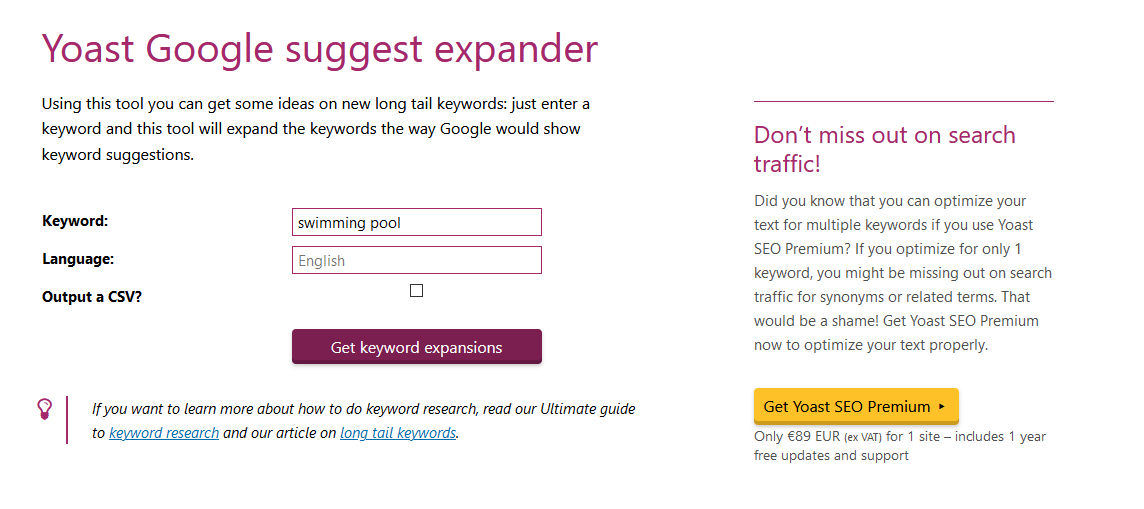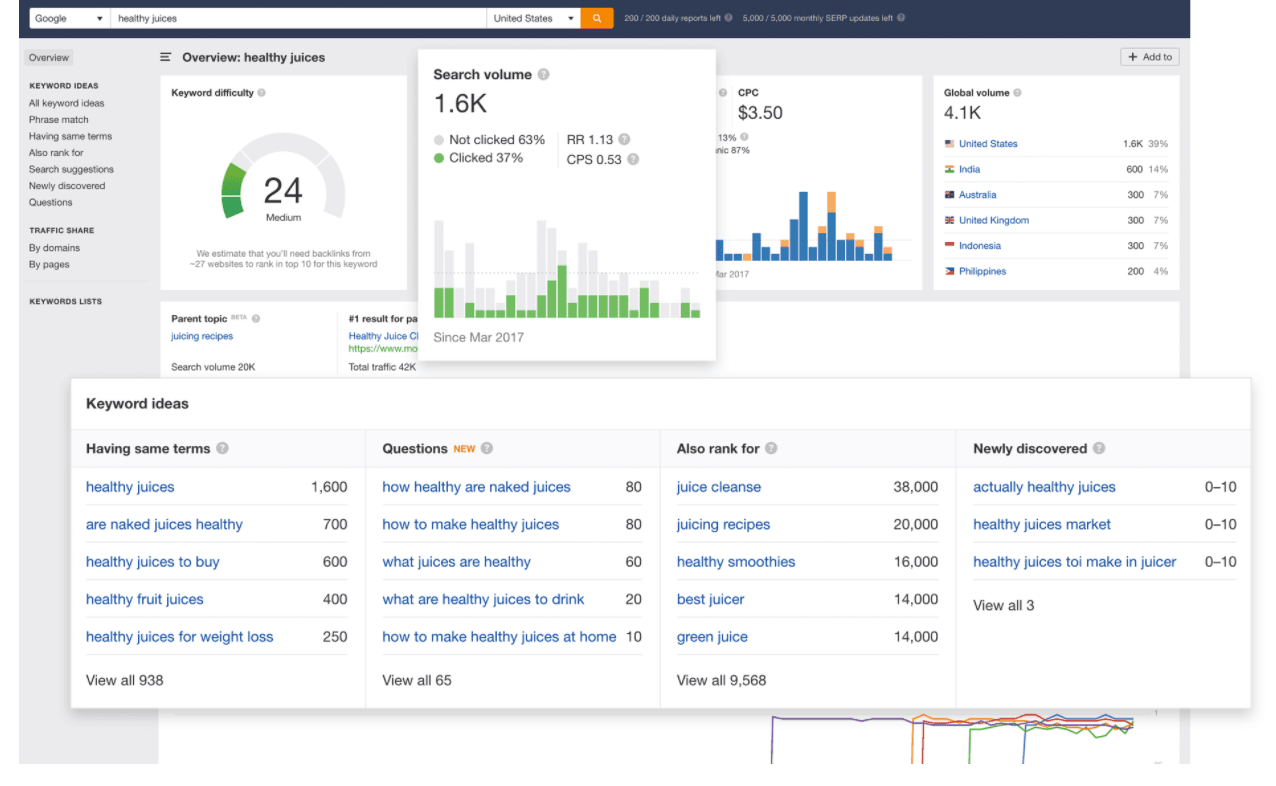Your average cold-call or direct mail campaign has only a 2% chance of converting a lead into a paying customer.
Inbound marketing campaigns that direct leads to your website through major search engines like Google, on the other hand, convert closer to 12% of leads. Connecting with the people who are already searching for the products and services you offer is a key growth driver, and search engine optimization (SEO) with keyword research is how you do it.
While it’s easy to get lost in the dizzying variety of metrics, applications, and services you can use for keyword research, the process itself doesn’t have to be complicated or expensive.
The Value of Keyword Research
Keywords are the tools search engines use to connect your website with its visitors. The first step to connecting with the people who are already looking for your product or service is creating content that includes the specific terms they are searching for. This is where keyword research comes in. Keyword research tools reveal the exact queries people use to find sites like yours, and they help identify the keywords your domain can successfully compete for. In the marketing realm, where we balance art and science, keyword data is a solid springboard for your content creation efforts.
Furthermore, of the billions of search queries Google processes on any given day, 15% are entirely new, never-before-seen phrases. For business owners looking to capitalize on the impressive returns that search engine marketing offers, finding those terms and creating content that uses them naturally is a winning strategy.
What Is Keyword Competition?
Keyword competition refers to how difficult it is for your website or content to rank highly in search results for a particular keyword or phrase. Difficulty is rated on a scale of 1-100; the higher the score, the more competitive the keyword is in organic search.
Essentially, it’s a measure of how many websites are trying to rank for the same keyword. The more popular or valuable a keyword is—because lots of people are searching for it—the more websites will target it, which increases competition.
When you’re planning your SEO strategy, understanding keyword competition helps you decide whether it’s worth going after a particular keyword or if you should focus on something with less competition but still relevant to your audience.
Why Keyword Competition Matters
Keywords are just one of many moving parts of SEO. But keyword competition directly impacts your ability to get your content seen by your target audience.
When you’re trying to rank for highly competitive keywords, it’s harder to break through the noise because you’re up against well-established websites or big companies. They may have more resources for SEO, like better content, backlinks, and authority.
This means you’ll need to put in extra effort—like creating top-notch content, building more backlinks, or improving your website’s SEO—to compete for that keyword.
On the flip side, if you target less competitive keywords (often but not always long-tail keywords), you have a better chance of ranking higher on search engines, even with less effort. These keywords may have lower search volumes, but they often attract more relevant traffic—people who are specifically looking for what you offer.
Ultimately, you want each piece of content you create to deliver the biggest impact possible. When you target keywords within your reach, you have a better chance of achieving your content goals.
The Four Types of Keyword Search Queries
In tandem with keyword competition, you also want to consider search intent to maximize the ROI of your keyword research. Subtle differences in search intent, the purpose or desired outcome of a user’s online search, can inform campaigns, product releases, customer service, and much more. Knowing the intention connected to a search phrase can make the difference between a wildly successful campaign and the marketing equivalent of crickets chirping at night.
Broadly speaking, there are four categories of search intent. Let’s introduce each one with some examples:
1. Informational
-
- “Are potatoes safe for dogs to eat?”
- “How to grow my email list”
- “Best Indian food recipes”
Informational search queries represent people who want answers to their questions. Google AI Overviews (previously known as Google Snippets) can often answer these questions directly in the search results. Some of these users may eventually buy things related to their searches, but many will simply get the information they’re looking for and move on.
2. Navigational
-
- “Facebook Ads Manager”
- “Google Maps”
- “WhatsApp for Desktop”
Navigational searches almost always have to do with a particular website. Not everyone uses their browser’s bookmarks. Your website should be easily available to users looking for it through search engines. Many first-time search engine marketers make the mistake of optimizing their home page for “home page” instead of a search phrase people will actually use to find their business.
3. Commercial
-
- “Pharmacies near me”
- “Best clothes for winter”
- “Certified coding bootcamps”
Commercial searches indicate users who have identified a want of some kind. They are actively looking for products and services that will meet that want but are not yet fully committed to one over another. Commercial searches often include generalized, highly competitive keywords that are difficult to rank well for.
4. Transactional
-
- “Plane tickets from New York to London”
- “iPhone 12 Pro 128GB graphite price”
- “Buy single-origin Hawaii Kona coffee beans online”
People who search for highly specific products along with words like “buy,” “price,” or “online” are often mere moments away from making a purchase. These are people who have already done their research. They know exactly what they want, and they are ready to get it.
It’s no coincidence that transactional search phrases tend to be the most competitive keywords. These long, highly targeted search phrases are often called long-tail keywords because they combine a generic keyword (“buy coffee online”) with a set of qualifiers (“single-origin,” “Hawaii Kona,” “beans”).
One of the simplest ways to categorize a keyword is by searching for it. If the top-ranking results all fall into a specific search intent category, that means the search engine has identified that particular intent behind the search.

How to Do Keyword Research for Content Marketing
Marketers who sell SEO services will spend a great deal of time and energy perfecting their keyword approach. While this dedication definitely pays off, it’s not in every business owner’s budget.
Fortunately, every entrepreneur with a nuanced understanding of their value proposition and their ideal clientele can perform keyword research. The main skill you will need is the ability to think like your customer.
Step One: Make a Robust List of Potential Search Terms
Start by brainstorming potential search queries that someone looking for your products or services may use. Many of these will be obvious—a business that sells manufacturing equipment will want to include the products its equipment can make.
Other potential search terms will require a bit of lateral thinking. Perhaps your number-one competitor has lower prices than you do but a far higher volume of customer support requests. You should include keywords that speak to your company’s competitive advantages. In this case, that might mean “most reliable [product]” or “my [product] doesn’t work.”
You can often come across these potential search terms on boards and forums where your customers typically gather. What questions are they frequently asking? You can even find related search terms using Wikipedia—just look at the table of contents for the pages that describe your industry—or Answer the Public. The latter insightful tool displays the top questions, prepositions, and comparisons related to your search term to help you find additional keywords that people are actually using to search on Google, YouTube, TikTok, and Amazon.

Learning how to find keywords online can be a marketing exercise in itself. Once you have between thirty and forty potential search terms, you can move on to the next step.
Step Two: Classify Your Terms
There are two broad types of keywords that you should pay attention to:
- Foundational. These are the search phrases that are essential to what your business does. Unless you are releasing some kind of innovative, never-before-seen product, these terms are virtually guaranteed to be highly competitive. Ranking for them can take years of dedicated work.
- Long-Tail. These are longer search terms with conditions and qualifiers that narrow down the user’s intent. Users searching for these terms are far more likely to make purchases soon.
Most marketers recommend focusing your marketing efforts on high-volume, low-competition, long-tail keywords. Consider the difference between someone searching for “people management tools” and someone searching for “performance management software with 360 feedback tool.” The latter search term describes a user who has already decided what kind of tool they want and is practically ready to sign on with the first reputable company they talk to.
Identify Long-Tail Keywords Your Buyer Personas Will Use
The fastest way to obtain SEO results is by focusing on long-tail, transactional keywords that your buyers are likely to use. Concentrating your efforts on the people most likely to convert is much quicker than hand-holding them all the way from the beginning.
If you’ve made comprehensive buyer personas, you should be able to create long-tail qualifiers that address their needs. These will differentiate you from competitors who may be chasing similar search phrases.
Step Three: Find the Best Keyword Research Tool for Your Business
Now that you have a handful of long-tail keywords that your ideal customer is using, you are ready to conduct keyword research with a user-friendly SEO tool. There are many tools out there, ranging from free-to-use services to expensive, all-in-one powerhouse marketing software suites. Most business owners will want to start with one of the following free and low-budget options.
Google Trends (FREE)
Google Trends will give you a wealth of free information about your keywords. You can use it to compare search volumes between keywords, identify seasonal trends over time, and even pinpoint relevant product categories for related topics.

Yoast Suggest (FREE version)
Yoast Suggest will expand your chosen keyword and identify a range of useful long-tail keywords that you can add to your list. The tool is free-to-use, but some of its more powerful features require purchasing a subscription.

SEMrush (FREE version)
SEMrush will let you use its Keyword Magic tool for free while keeping its most valuable features behind a paywall. Millions of professional marketers use SEMrush every day, making it a valuable addition to your company if you choose to invest more time and energy into learning how to do keyword research for content marketing and rank for high-volume search terms.

Keywordtool.io (FREE)
Keywordtool.io helpfully lets users qualify their keywords on multiple platforms, including Google, YouTube, Amazon, Instagram, Twitter, and even the Google Play store. This makes it incredibly useful for companies that want to rank on platform-specific searches—for example, your app doesn’t need to show up on a Google search if it ranks well on the Play store.

Ahrefs ($7 trial)
Ahrefs uses automated systems to glean keyword insights from 10 different search engines and their users. The Ahrefs Keyword Explorer tool can tell you how many people are searching for specific keywords, how well competitor websites rank for keywords, and even how difficult ranking for any particular keyword is going to be for you.

All of these tools serve a similar function. They give you search volume and keyword competitiveness data for your chosen keywords. Some of them suggest new keywords that offer higher volume, lower competition, or both. The important thing is that you focus your web content on the transactional search phrases that offer the highest volume with the lowest competition. That is where your SEO marketing campaign will earn its first conversions.
Step Four: Start Writing Content!
Once you have selected a few search terms that have the magic combination of high search volume and low competitiveness, you are ready to start writing content that incorporates those terms. Creating an editorial calendar can help you keep track of keyword progress while ensuring you always have new topics to write about. The better you address your users’ needs through the particular long-tail keywords they use, the more profitable your SEO campaign will be.
While keywords are just one of the 200 ranking factors that Google takes into account when ranking web content, it’s an important one that will inform the rest of your marketing initiatives.

